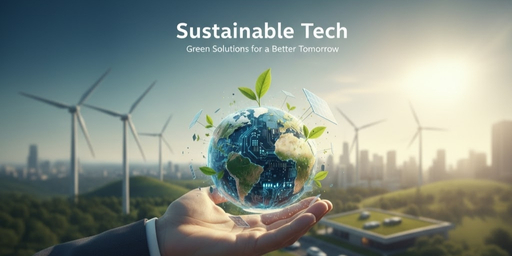As climate is changing, resource scarcity occurring, and environmental destruction continue to be significant challenges, sustainable technology has emerged as an important solution. Across all fields, companies are beginning to see the value in using green solutions not just for business performance, but for the good of the environment. With the merger of innovation and responsibility, sustainable technology offers a way for a greener and more resilient future.
What Is Sustainable Technology?
Sustainable technology involves innovations that reduce harmful environmental impacts, preserve natural resources, and promote long-term natural ecological balance. Sustainable technologies are developed with considerations for the environment, society, and economic viability, usually involving the use of renewable resources, reduced emissions, and energy efficiency. Sustainable technology aims to meet present day needs without compromising the needs of future generations.
Whether through renewable energy systems, sustainable manufacturing systems, smart infrastructure, or circular economy systems, sustainable technology is changing how we produce, consume, and innovate.
The Business Case for Green Innovation
The use of sustainable technology is no longer simply a function of corporate social responsibility; it has become a business necessity. Organizations that utilize green technologies in their operations will be best suited to reduce operational costs, manage regulatory risks, and continue fostering strong relationships with stakeholders.
The benefits of this include:
- Cost Savings: Tech solutions like energy-efficient systems, waste reduction systems, or water-saving technologies provide meaningful savings over time.
- Brand Credibility: Consumers today are more environmentally conscious than ever and prefer to deal with brands that are seriously focused on environmental sustainability.
- Regulatory Compliance: Environmental regulations are being strengthened across the globe. Companies that make the investment into sustainable technologies will have an advantage in being compliant.
- Attractive Investment: Companies that decide to adopt sustainable practices will benefit from investor demand for Environmental, Social, and Governance (ESG) metrics in their decision making process.
Emerging Trends in Sustainable Tech
The field of green technology is changing quickly. Here are a few trends to watch across sectors:
Renewable Energy Technologies
Solar, wind, and hydroelectric power are no longer alternative as they once were; they’re going mainstream. Advances in energy storage, such as batteries and smart grids, are making renewable energy more viable and practical. More businesses are installing renewables onsite or purchasing green energy credits to reduce their carbon footprint.
Circular Economy and Waste Reduction
A circular economy aims to avoid waste through the reuse, refurbishment, and recycling of materials. Technologies that support product lifecycle management, like digital twins and blockchain for traceability, enable companies to design products with sustainability in mind. This not only reduces environmental impact, but also generates new business opportunities associated with resource recovery and extending product value.
Sustainable Manufacturing and Industry 4.0
Technologies related to Industry 4.0—such as AI, IoT, and machine learning—are improving operational efficiencies and decreasing waste in the manufacturing process. Intelligent sensors can help to improve energy efficiency, while predictive maintenance can both decrease resource consumption and equipment downtime. Sustainable materials including biodegradable polymers and recycled composites are also becoming more common in product development.
Green Building and Smart Infrastructure
Sustainable architecture and smart infrastructure are reshaping cities. Developments like energy-efficient HVAC systems, green roofs, and smart lighting are all contributing to lower emissions and improved livability. IoT-enabled infrastructure will help monitor and manage resource use in real time, thus fostering urban development with sustainability.
Eco-Friendly IT and Cloud Solutions
The digital sphere also contributes to sustainability. Data centers rank among the highest energy consumers on earth. At the same time, green IT advances, such as energy-efficient hardware and cloud computing that utilizes renewable energy, are reducing the environmental footprint of the ICT sector. Virtual collaboration tools and remote work technologies also contribute to reducing travel-related carbon emissions.
Commitment to Sustainability
Sustainability plays a central role in the values and models of organizations today. Innovation and environmental responsibility are becoming more widely recognized as interconnected priorities. Organizations have many objectives when they invest in sustainable technology:
- Decrease their environmental footprint throughout the value chain.
- Assist clients achieving their sustainability objectives.
- Collaborate with their partners to advance green innovations.
- Provide learning opportunities to internal staff so that they champion sustainability.
The usual projects involve energy efficient facilities, reduced resource consumption, waste reduction, and embedding circular economy into operational models. Investment in research and development allows them to produce performance-based solutions that are also environmentally responsible.
The Road Ahead
Sustainable technology is not a one time concept to adopt. It is a continuous act of innovation, adaptation, and responsible long-term commitment. As we address climate change, depletion of resources, and increasing environmental pressures, transitioning to green solutions for sustainable development is an urgent priority for long-term resilience and responsible growth.
The responsibility to act is shared among governments, businesses, and individual people. By prioritising sustainability, organizations will help lead the world’s transition towards clean, resilient, and equitable solutions.
Stakeholders, including customers, partners, employees, and communities, are invited to contribute to co-creating a better future through leadership in sustainable innovation.

